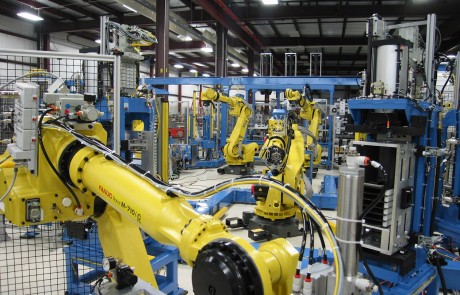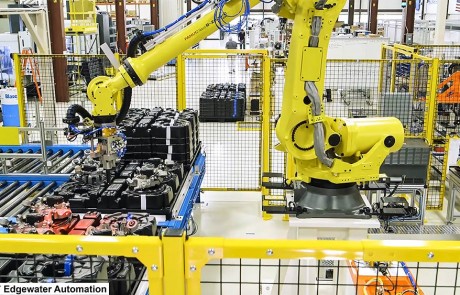Material handling systems are used for everything that happens after a product is manufactured: the movement, storage, and control of products and materials from the manufacturing plant, through warehousing and distribution, to the end user. Material handling systems generally include a combination of manual, automated, and autonomous solutions. Dock workers, for instance, manually unload a truck, while an automated fixed-camera machine vision system scans the pallet bar code as it passes through the shipping doors, and an autonomous forklift carries the pallet from the staging area to final rack and storage.
The Four Basic Types of Material Handling Systems
Edgewater Automation has extensive expertise with all four primary types of material handling systems, including engineered systems, industrial trucking, storage, and bulk materials.
Engineered systems such as robotic palletizers, conveyors, sortation equipment, dimensioners, automated ID systems, and more are Edgewater Automation’s bread and butter. Our network of leading material handling systems service and component suppliers means that we can help guide your next engineered material handling system to achieve the performance you need without additional costs that you don’t.
Industrial trucks include forklifts, lift assists, side loaders, pallet jacks, and more, while storage systems refer to warehouse racking and storage areas. Finally, bulk material handling systems are used widely in process industries, including food and beverage, and those that require custom containers.
Parts-Feeding
Parts-Feeding solutions help manufacturers to sort, guide, and position component parts for subsequent handling and assembly into subassemblies and final products. Standard automation solutions for parts-feeding applications include vibratory feeds, which use physical movement to separate and singulate parts through a chute, transfer buffer, or other delivery mechanism. Step feeds employ custom structures, ladders, chutes, and structured bowls to gently help separate the parts inside, while blow feeds rely on compressed air for high-volume feeding operations. The vibratory systems or feeding systems receive the parts in bulk, place them in the required position, and supply them to the following stage of the production process at the speed and rate necessary for optimal functioning of the process. Finally, many industries, such as electronics, use custom trays for temporary storage and transfer of high-value parts. Edgewater has extensive expertise in all these part feeding solutions.
Packaging
Packaging is a common application that Edgewater develops. Today, e-commerce is reshaping supply chains from automobiles to groceries. Industries that once sold 100% of their products through brick-and-mortar storefronts are now integrating and engineering their brands into their product packages. As a result of e-commerce’s growth and the reduction of in-person shopping, packaging products so that they can be traced from manufacturing origin to final destination is critical to modern manufacturing operations. Edgewater’s expertise in robotic automation as well as discreet printing, packaging, and converting equipment means we have the knowledge and expertise you need to cost-effectively develop your next packaging material handling system.
Dispense and Cure
Dispense and Cure are critical operations for products that use glues or sealants that need to be cured before final shipping. The automotive industry, for example, widely uses dispensing robots to seal doors and gaskets, paint automotive bodies, and protect potting components against environmental dangers. Packaging also widely uses glues that need to be cured with UV light and then verified as cured by using ultraviolet or infrared machine vision to measure water content in the adhesive. In other cases, induction or convection ovens are used to cure materials. Let Edgewater engineers share the benefits of their hundreds of man-years of experience in Dispense and Cure applications with your before you begin designing your next automated dispensing solution.

